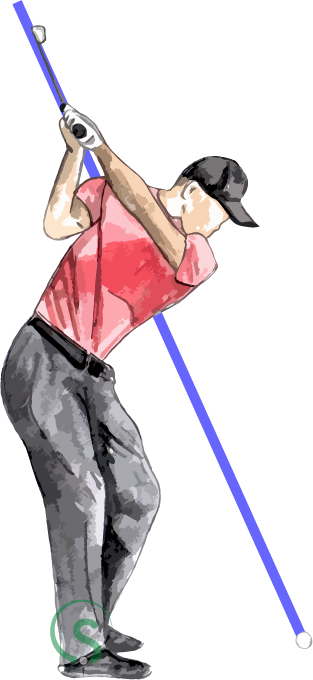The Turned Shoulder Plane
The next plane we’ll look at is the Turned Shoulder Plane. Mr Kelley states: “This reference point is primarily the point reached by the right shoulder after a Flat Backstroke Shoulder Turn.”(1) The key point for consideration here is the capitalised “Flat Backstroke Shoulder Turn”. This is a specific variation of the shoulder turn component of the swing, described by Mr Kelley as: “...a relatively flat backstroke shoulder turn which places the shoulder “on plane” for any plane angle with a flatter angle than the Rotated Shoulder Angle.”(2)
Of course, this description doesn’t make much sense until we know what a “Rotated Shoulder Turn” is. This is simply where the “...shoulder turn moves the (right) shoulder in a “normal” path - at right angles to the spine.”(3)
Of course, this description doesn’t make much sense until we know what a “Rotated Shoulder Turn” is. This is simply where the “...shoulder turn moves the (right) shoulder in a “normal” path - at right angles to the spine.”(3)

So there we have it. A “Flat Backstroke Shoulder Turn” is where the right shoulder moves in a relatively flat (horizontal) motion... but in reality, it’s anything flatter than the right shoulder moving in a path 90° to the spine.
That being said, a “Rotated Shoulder Turn” is subject to the spine angle, meaning if you set up to the ball relatively upright, turning your shoulders at right angles to the spine could be argued to be both “flat” and “rotated” at the same time...
Luckily we don’t have to go into too many hypothetical backswing scenarios because Mr Kelley kindly states: “But any other shoulder turn can also provide the acceptable reference point” for our Turned Shoulder Plane.(4) With that in mind I, personally, use any golfer’s right shoulder position at the top of their swing as the reference point for the Turned Shoulder Plane.
Unlike the previous Elbow Plane, or the Squared Shoulder Plane next, there is no accurate way to draw this plane by simply looking at address. Although you can draw a line representing the shoulder turning on the particular plane (be it “flat”, “rotated” or whatever), you can’t: A) predict what type of shoulder turn a golfer will make until they do it, and B) know where exactly the right shoulder will be when they turn on a particular plane. This is because you can’t tell at address how broad a person is (the broader the shoulders, the further away from the address position the right shoulder will be), and also how much of a shoulder turn a person will make (a “full” 90° shoulder turn will move the right shoulder further than a 45° shoulder turn).
With all this in mind, the most accurate way to find the reference point for the Turned Shoulder Plane, is to see where the right shoulder is at the top of the swing et voilà, it’s there.
That being said, a “Rotated Shoulder Turn” is subject to the spine angle, meaning if you set up to the ball relatively upright, turning your shoulders at right angles to the spine could be argued to be both “flat” and “rotated” at the same time...
Luckily we don’t have to go into too many hypothetical backswing scenarios because Mr Kelley kindly states: “But any other shoulder turn can also provide the acceptable reference point” for our Turned Shoulder Plane.(4) With that in mind I, personally, use any golfer’s right shoulder position at the top of their swing as the reference point for the Turned Shoulder Plane.
Unlike the previous Elbow Plane, or the Squared Shoulder Plane next, there is no accurate way to draw this plane by simply looking at address. Although you can draw a line representing the shoulder turning on the particular plane (be it “flat”, “rotated” or whatever), you can’t: A) predict what type of shoulder turn a golfer will make until they do it, and B) know where exactly the right shoulder will be when they turn on a particular plane. This is because you can’t tell at address how broad a person is (the broader the shoulders, the further away from the address position the right shoulder will be), and also how much of a shoulder turn a person will make (a “full” 90° shoulder turn will move the right shoulder further than a 45° shoulder turn).
With all this in mind, the most accurate way to find the reference point for the Turned Shoulder Plane, is to see where the right shoulder is at the top of the swing et voilà, it’s there.
